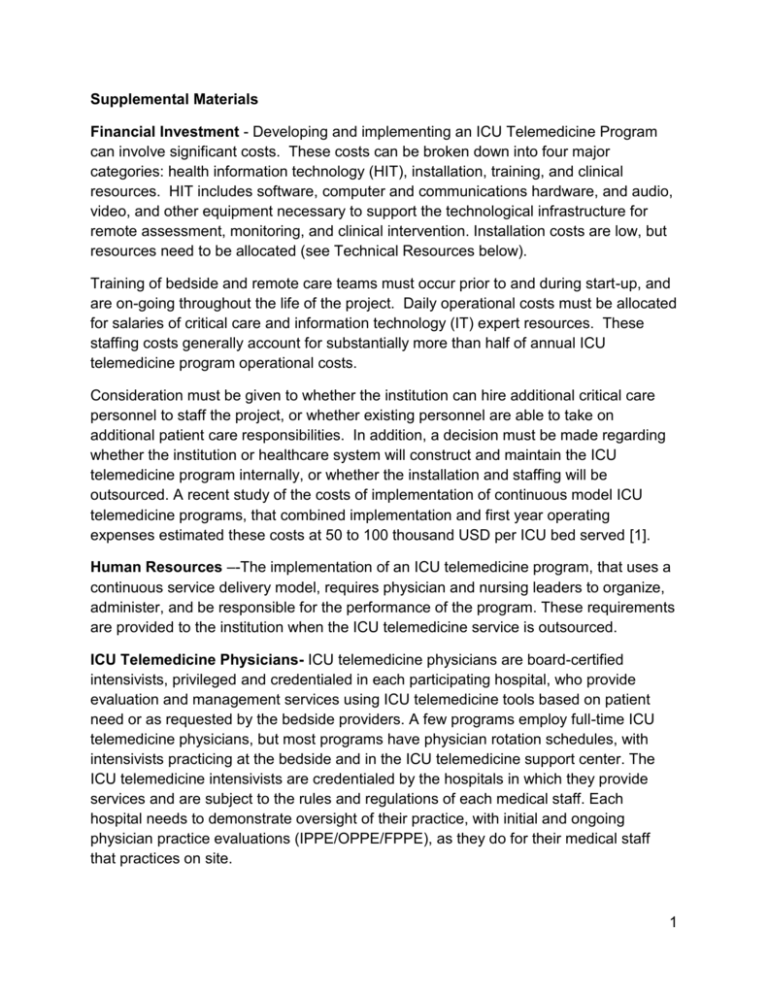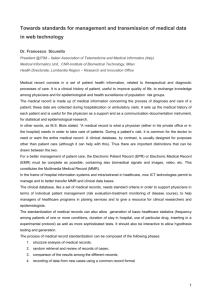Supplemental Materials Financial Investment
advertisement

Supplemental Materials Financial Investment - Developing and implementing an ICU Telemedicine Program can involve significant costs. These costs can be broken down into four major categories: health information technology (HIT), installation, training, and clinical resources. HIT includes software, computer and communications hardware, and audio, video, and other equipment necessary to support the technological infrastructure for remote assessment, monitoring, and clinical intervention. Installation costs are low, but resources need to be allocated (see Technical Resources below). Training of bedside and remote care teams must occur prior to and during start-up, and are on-going throughout the life of the project. Daily operational costs must be allocated for salaries of critical care and information technology (IT) expert resources. These staffing costs generally account for substantially more than half of annual ICU telemedicine program operational costs. Consideration must be given to whether the institution can hire additional critical care personnel to staff the project, or whether existing personnel are able to take on additional patient care responsibilities. In addition, a decision must be made regarding whether the institution or healthcare system will construct and maintain the ICU telemedicine program internally, or whether the installation and staffing will be outsourced. A recent study of the costs of implementation of continuous model ICU telemedicine programs, that combined implementation and first year operating expenses estimated these costs at 50 to 100 thousand USD per ICU bed served [1]. Human Resources –-The implementation of an ICU telemedicine program, that uses a continuous service delivery model, requires physician and nursing leaders to organize, administer, and be responsible for the performance of the program. These requirements are provided to the institution when the ICU telemedicine service is outsourced. ICU Telemedicine Physicians- ICU telemedicine physicians are board-certified intensivists, privileged and credentialed in each participating hospital, who provide evaluation and management services using ICU telemedicine tools based on patient need or as requested by the bedside providers. A few programs employ full-time ICU telemedicine physicians, but most programs have physician rotation schedules, with intensivists practicing at the bedside and in the ICU telemedicine support center. The ICU telemedicine intensivists are credentialed by the hospitals in which they provide services and are subject to the rules and regulations of each medical staff. Each hospital needs to demonstrate oversight of their practice, with initial and ongoing physician practice evaluations (IPPE/OPPE/FPPE), as they do for their medical staff that practices on site. 1 ICU Telemedicine Nurses- ICU telemedicine nurses are critical care nurses experienced in caring for and responding to patients with life-threatening problems. They possess high level expertise in assessment, therapies, interventions and continuous nursing vigilance for critically ill patients in complex environments. They are key members of the ICU telemedicine team and must also be skilled in communication, collaboration, decision-making, systems thinking, and computer literacy [2]. CCRN-E re-certification or initial certification by exam is available for nurses who primarily or exclusively monitor and care for acutely and/or critically ill adult patients in an ICU telemedicine [3]. Technical Resources and Planning- The more extensive and up to date the preexisting infrastructure, including computerized information systems, physiological monitors, clinical pathology laboratory data collection, image archiving and communication systems, medication administration system, electronic medical record, and telecommunications connectivity, the lower the implementation costs will be. Bioengineering and IT resources are needed for installation and maintenance of the electronic infrastructure, which includes central and bedside hardware, hidden components, and the interfacing of ICU telemedicine communication components with existing hospital information systems. Established standards for maintaining the security and privacy of protected health information must be met within the constituent systems and during transmission of protected health or personal information. Some parts of the country are affected by the lack of nationwide availability of high-speed network connectivity, i.e. broadband access in rural areas. Cultural and Organizational Readiness- This area has been identified and documented within healthcare organizations by the IOM as having generated walls of resistance to any type of change in current patient care delivery procedures. Organizational inertia continues to be an issue for healthcare institutions worldwide, and the ICU telemedicine environment is not immune to these sources of resistance to change. Success of the program hinges on buy-in from the ICU medical director, ICU nursing director, key physician leaders, as well as support from the high admitting physicians to the ICU. There also must be a clear vision and direction from executive and physician leadership and well-defined program goals, with agreement both in principal and practice. There must be a clear communication throughout the medical institution of the need for change, which includes a desire for many or all of the following: o Quality improvement/better outcomes 2 o o o o o o o o o o o o Best practice compliance for public reporting and better outcomes Data to drive improvements and measure outcomes Avoidance of sentinel events Prevention of physician/nurse burnout Improvement in physician/nurse quality of life Nursing retention Increased patient volume Physician/nurse recruitment Leapfrog and regulatory compliance Perception of quality by the community Increase in market share Improved financial performance through improved resource utilization Finally, the medical staff must be aligned to understand the collaborative model, and should be willing to explore the entire spectrum of benefits that capable, remote medical staff, with delegated patient management authority, can provide. Intellectual Property Considerations- Intellectual property or patents for ICU telemedicine systems has been seen as a barrier to implementation for remote critical care services. Health systems have been leery about investing scarce capital resources into telemedicine technology with potentially burdensome patent restrictions that may inhibit later system development and improvement. These concerns have been reduced with the increased number of vendors entering this space. Medicare/Medicaid- Category 3 (data collection) codes for ICU telemedicine services exist, but these costs are not currently reimbursed by the Centers for Medicare and Medicaid Services (CMS). Medicare- Partial Medicare reimbursement for telehealth services was authorized in the Balanced Budget Act of 1997 (BBA). The narrow scope of reimbursement prompted efforts towards expansion and revision of Medicare reimbursement regulations. The Benefits Improvement and Protection Act of 2000 (BIPA) included amendments to the Social Security Act and removed some of the prior constraints, yet maintained substantial limitations on geographic location, originating sites, and eligible telehealth services. Medicare beneficiaries are eligible for telehealth services only if the telehealth services are received at an “originating site” (where the patient is situated) located in a rural Health Professional Shortage Area or in a county outside of a Metropolitan Statistical Area. Entities that participate in a Federal telemedicine demonstration project approved by (or receiving funding from) the Secretary of the Department of Health and Human Services as of December 31, 2000, qualify as originating sites regardless of geographic location. 3 Private Payers-: Payers such as Blue Cross/Blue Shield, Aetna, United Healthcare, AFLAC, etc. operate under individual state regulations. As such, each commercial payer may or may not offer reimbursement for telemedicine services largely as a function of state legislation. As of 2012, 15 states mandate some form of payment for telemedicine services. Not all mandate parity of payment for telemedicine services, that is, payment independent of whether the services are provided face-to-face or via remote technology. States with legislation favorable to telemedicine reimbursement include California, Colorado, Georgia, Hawaii, Kentucky, Louisiana, Maine, Michigan, New Hampshire, Oklahoma, Oregon, Texas, Virginia, Maryland and Vermont. There are variations of the reimbursement schemes, from state to state. For Instance, within the State of Maryland, reimbursement is in parity with billings/payments for services independent of whether the services are performed remotely or eye-to-eye. Vermont has a variable reimbursement schedule dependent upon how the care is delivered. Documentation required for reimbursement for telemedicine services will also vary. Some states require documentation that is difficult or impossible for ICU telemedicine providers to meet. On the other hand, billing for critical care time (99291 or 99292) may subvert excessive documentation requirements. Non Professional Services Sources of ICU Telemedicine Program Revenue-There are few studies of the financial impacts of ICU telemedicine programs that use activitybased cost (ABC) accounting procedures. One independent, non-peer reviewed study that used ABC procedures and included financial auditing by Price Waterhouse Coopers indicated that community hospitals could increase revenues significantly above the costs of an ICU telemedicine program by decreasing referrals to tertiary medical centers [4]. Using ICU telemedicine resources provided by a referral academic medical center community hospitals were able to keep higher acuity patients with sepsis, congestive heart failure, respiratory failure, and drug overdose in the community with population case fatality rates that were similar to those when more of these cases were referred for tertiary care. There were financially impactful reductions in the cost of care to society because providing this care at community hospitals was less costly. Increased community hospital revenue from increased volume of higher acuity cases was substantially in excess of their 50 to 100 thousand USD per bed per year costs of the program. This outreach revenue is one of the sources of financial support for providers of ICU telemedicine services in the current reimbursement environment. Another source is increased ICU volume at the institution that provides ICU telemedicine services. Many implementations have been associated with decreased LOS that is attributable in part to improved adherence to ICU best practices. This increased operational efficiency allows reduction of fixed costs when demand for ICU services is lower than or increased case volume when demand for ICU services is higher than local supply. There is an urgent need for studies that use ABC accounting 4 methods to report the effects of ICU telemedicine program implementation on case volume and costs. A third source of ICU telemedicine program revenue is from third party payers. Governmental agencies charged with increasing access to care including HRSA have supported the implementation of telemedicine programs in rural settings [5, 6]. Private insurers including Blue Cross have invested in telemedicine programs including a rural health program in California [7] and an ICU telemedicine program serving the states of Maine and Maryland. Regulatory Requirements for ICU Telemedicine Providers- At present there is no ambiguity regarding physician licensing across state lines, since physician credentialing, local accountability, and liability across state lines requires that physicians be licensed in the state(s) in which their patients are hospitalized. The need for individual State licenses adds to the cost and complexity of providing ICU telemedicine across multiple States. ICU telemedicine providers also need to be able to prescribe controlled substances in each of these States. Knowledge of each State’s rules and regulations as they apply to collaborative practices with Allied Providers require diligent evaluation and/or legal support, as currently there is no national standard. CMS has recently changed their policy and now allow credentialing by proxy when agreements are in place between hospitals. This should allow for more efficient and lower cost credentialing for ICU telemedicine providers. References 1. 2. 3. 4. 5. 6. Kumar G, Falk DM, Bonello RS, Kahn JM, Perencevich E, Cram P: The costs of critical care telemedicine programs: a systematic review and analysis. Chest 2013, 143(1):19-29. Barden C, Davis T, Seckel M, Aust MP, Deibert W, Griffin P, Hawkins C, Herr P, Jenkins C, McCarthy M et al: AACN Tele-ICU Nursing Practice Guidelines. In. Edited by Aust MP. Aliso Viejo, CA: American Association of Critical-Care Nurses; 2013. Goran SF: A new view: tele-intensive care unit competencies. Crit Care Nurse 2011, 31(5):17-29. Fifer S, Everett W, Adams M, Vincequere J, Massachusetts Technology C, New England Healthcare I: Critical care, critical choices the case for tele-ICUs in intensive care. [Cambridge, Mass.?]; [Boston, Mass.?]: New England Healthcare Institute ; Massachusetts Technology Collaborative; 2010. Puskin DS, Cohen Z, Ferguson AS, Krupinski E, Spaulding R: Implementation and evaluation of telehealth tools and technologies. Telemed J E Health 2010, 16(1):96-102. States U: Grantee directory. . In. Edited by Technology OftAo. Washington, D.C.: United States Goverenment. 5 7. program BCoCgmfrt: Blue Cross of California gets $1.8 million for rural telemedicine program. Telemed Virtual Real 1998. 6








